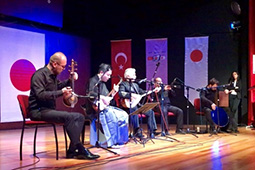
Shamisen player Honjoh Hidejiro 
Honjoh Hidejiro with Necmi Kıran, a saz (Turkish long-necked guitar) player and conductor 
Honjoh Hidejiro (second left) performing with players of traditional instruments in Ankara, Turkey
- PREVIOUS
- NEXT
November 2021
A Musician Connecting the Shamisen with Contemporary Music Overseas

Every year the Agency for Cultural Affairs, Government of Japan, appoints a number of “Japan Cultural Envoys” to engage in cultural activities overseas. The undertaking aims to deepen understanding of different aspects of Japanese culture among people of the world and build and strengthen networks between Japanese and foreign artists and experts. In this first installment of a new series introducing such Japan Cultural Envoys, we meet Honjoh Hidejiro, a shamisen player.
The shamisen is a traditional Japanese instrument with three strings stretched over a long neck and resonating body, and which is played with a plectrum called a bachi. The instrument is played solo or in ensembles with other Japanese instruments, and provides an essential musical accompaniment to traditional performing arts such as bunraku puppet theater, kabuki theater and Nihonbuyo (Japanese classical dance). In recent years, the shamisen has also been played in non-traditional genres.
One shamisen virtuoso is pursuing the instrument’s potential by working to produce modern shamisen music while commissioning composers of contemporary music in Japan and abroad to create new compositions. His name is Honjoh Hidejiro.
Honjoh Hidejiro toured eight countries (Turkey, the USA, Italy, France, the UK, Germany, the Czech Republic, and Russia) from March to October of 2018 as a Japan Cultural Envoy* appointed by the Agency for Cultural Affairs, Government of Japan, working on ambitious collaborations with many local performers and putting special effort into creating new compositions. He commissioned composers in each country to write ensemble works for shamisen and bassoon, as well as shamisen concertos with orchestra, and he worked enthusiastically on the performances of these pieces.

“When I became a Japan Cultural Envoy, I wanted to take on challenges that I wouldn’t be able to take on normally. It was harder than I expected to commission new works by local composers, work on adjusting the completed works, and perform them. It isn’t an overstatement to say that it was incredibly demanding. But I didn’t want to stop at just introducing the shamisen. I think I was able to push through because, above all else, I wanted to persist with my aggressive attitude of accumulating important experiences.”
The timbre of the shamisen, which is completely different from that of European stringed instruments, was met with surprise at his destinations. Not all of the commissioned composers understood the characteristics of the shamisen. Once the initial composition was submitted, Honjoh Hidejiro exchanged honest opinions with the composer before completing the work. During this process, he took care not to say, “I can’t do that.”
“I felt more things would be possible if we respected one another. While discussing the composed works, we adjusted them, performed them, and brought them to completion.”

In total, twenty-one new works were created as Honjoh Hidejiro stoically continued his challenge.
The shape and construction of the shamisen are similar to the banjo and guitar, but a special feature of the shamisen is the sawari. Honjoh Hidejiro explains: “There is a protruding device at the top of the neck that comes in contact with the thickest string and which can be raised or lowered. This is called the ‘sawari,’ and adjusting it helps to create the shamisen’s unique buzzing sound. The shamisen produces an extremely expansive sound with just three strings.”
Unlike Western instruments that produce melodies with many sounds, the shamisen seeks to express limited single tones by playing a single sound and letting it fall quiet. While this means that Honjo Hidejiro’s collaborators had to create compositions for an ensemble of musical instruments with completely different characteristics, he says that the performers from the various countries described it as “an extremely exciting experience.”
“The shamisen is a traditional instrument so there are classic compositions that should be passed down, but there is the potential also for the shamisen to connect with the diverse contemporary music world. We live in a world where various sounds can be produced digitally, but I hope to continue to expand the potential of music with sounds produced by traditional instruments,” he says.
Touring several countries as a Japan Cultural Envoy was a journey that aimed to realize that dream. As the result of the journey, Honjoh Hidejiro is further expanding his collaborations with people from around the world and creating still bigger dreams.
* The Agency for Cultural Affairs has been appointing people committed to cultural activities such as artists, cultural specialists and so on, as “Japan Cultural Envoys.” This undertaking aims to deepen the international community’s understanding of Japanese culture and to build and strengthen networks between Japanese and foreign artists and experts. https://warp.ndl.go.jp/info:ndljp/pid/12713430/www.culturalenvoy.bunka.go.jp/en/about.html
- PREVIOUS
- NEXT


